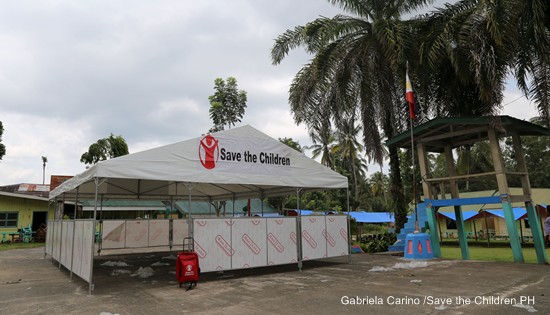Save the Children
Philippines steps up assistance to displaced children in
earthquake-hit areas in Mindanao

Press Release
November 13, 2019
MANILA – Save the
Children Philippines has delivered family hygiene kits and plastic
tarpaulins to ease the suffering of children and their families
affected by the series of strong earthquakes in Mindanao.
A total of 1,051 family
hygiene kits and 130 plastic tarpaulins have been distributed to
children and their families in the most affected towns of Makilala
and Magpet in North Cotabato to protect them from contagious
diseases while in cramped evacuation centers and while temporary
taking shelter in makeshift tents outside their damaged houses.
The humanitarian team of
Save the Children Philippines will set up temporary learning spaces
and distribute teaching kits starting this week to ensure displaced
learners can resume classes.
Lawyer Alberto Muyot,
chief executive officer of Save the Children Philippines said the
resumption of classes is critical to address psychosocial stress of
affected children because it re-establishes their routines.
“Keeping children safe
inside learning spaces is critical in times of emergencies. Children
know that education gives them power to build a better future,” said
Muyot in a statement.
Initial figures from the
Department of Education (DepEd) showed that some 3.2 million
school-age children have been affected by the series of earthquakes
that hit four regions in Mindanao including the war-torn Bangsamoro
Autonomous Region in Muslim Mindanao (BARMM) as well as Davao and
SOCCSKSARGEN regions. Out of the 3.2 million children, at least 1.6
million of them are in Davao, SOCCSKSARGEN, and BARMM, regions that
were affected by the earthquake.
Jerome Balinton,
humanitarian manager of Save the Children Philippines, said the
three temblors have caused massive destruction and damage to houses,
schools, roads and infrastructure and it may take years to complete
rehabilitation of the damaged infrastructure. Latest report from
DepEd as of Nov. 11 also show that 1,046 classrooms were totally
damaged, while some 1,274 classrooms sustained major damage.
“But children cannot wait.
The need for psychosocial support, shelter, water, hygiene and
sanitation and the resumption of classes in safe learning
environments is immediate and crucial to the recovery of children
and their families,” said Balinton.
At the moment, more than
11,000 families remain in evacuation centers, with limited access to
water and sanitation facilities. And with many schools being used as
evacuation centers, children’s learning is also affected. DepEd
report also shows that there are 41 schools used as evacuation
centers.
A total of 260,492 people
were affected by the three strong earthquakes across Mindanao, with
24 dead. Of the affected population, over 103,000 individuals are in
Makilala town.
“The numbers are expected
to escalate as most of the affected families live in hard to reach
areas,” said Balinton.